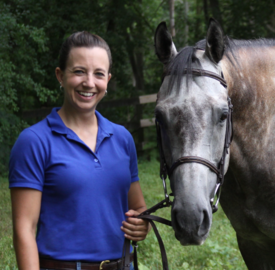
Dr. Sarah Peters attended Cornell University for a bachelor's in bioengineering and continued to the University of Pennsylvania for veterinary school. While going through her clinical rotations at New Bolton Center, she received three separate senior student awards in the departments of large animal medicine, large animal emergency, and critical care, and large animal diagnostic imaging and sports medicine. Dr. Peters then moved to Lexington, Kentucky, to complete an internship at Rood and Riddle Equine Hospital and further refine her knowledge and skills while working at one of the world's best equine hospitals. She then had an amazing opportunity to combine her bioengineering and veterinary backgrounds, completing a veterinary orthopedic research fellowship in Switzerland for the AO Foundation.
The AO is an international organization dedicated to education and advancement for musculoskeletal diseases. Completing courses provided by the AO is part of surgical residency training programs for physicians, as well as for veterinary surgeons. She then returned to New Bolton Center to work, learn and teach, completing their rigorous academic internship. She continued to refine her lameness, sports medicine, and surgical capabilities while working alongside some of the world's best equine veterinarians. She additionally is certified in veterinary spinal manipulative therapy (also known as "animal chiropractics") and after completing coursework from the University of Tennessee and the Orthopaedic Research Center at Colorado State University, is a certified equine rehabilitation practitioner. These certifications allow her to incorporate a variety of non-invasive therapeutic techniques to improve her patients' quality of movement as well as offer non-traditional pain management methods. Now in private practice, Dr. Peters consistently attends a variety of continuing education events each year to support her dedication to lifelong learning and continues to bring the most advanced knowledge and techniques to better serve her patients.
Forward Equine Veterinary Services, LLC, is a sports medicine and rehabilitation practice, owned and operated by Dr. Sarah Peters, providing care to horses of northern Illinois and eastern Wisconsin. Forward Equine is dedicated to helping your horse work at peak performance levels utilizing a combination of traditional and integrative medicine that incorporates state-of-the-art technologies and knowledge in the field. We are also committed to providing unparalleled and personal client support, whether you are a one-time client just in need of a pre-purchase examination or a long-standing client with horses that see Dr. Peters regularly to stay feeling and moving their best. If you have specific questions or concerns about your horse's performance or are looking for a specially trained veterinarian to be on your horse's team, Forward Equine is here to help!
Dr. Sarah Peters of Forward Equine Veterinary Services in Wisconsin and Illinois has worked as a solo equine sports medicine practitioner since the spring of 2016. Prior to launching her own practice, she earned her veterinary doctorate at the University of Pennsylvania, studied at Rood and Riddle Equine Hospital in Kentucky (regarded as one of the top equine facilities in the world), completed an orthopedic research fellowship at the AO Foundation in Switzerland, and is certified in veterinary spinal manipulation and equine rehabilitation. In other words, she knows her stuff – and she is impressed with the Assisi Loop. She works with a wide variety of horses in northern Illinois and southeastern Wisconsin, including hunter-jumpers, dressage competitors, barrel racers, and general pleasure horses. But, of course, “the big thing they all have in common is pain,” Dr. Peters says, “and we need to get rid of the pain so that they can return to normal function.”

On many horses she’s treated, Dr. Peters says, she has been particularly impressed with the speed at which the Loop works. Of course, any treatment can take time, depending on the animal, but she and her clients have often been lucky enough to see a vast improvement in a short amount of time. “The best feedback is when they use the Loop and two days later the horse walks out of the stall better, and they have literally done nothing else – they haven’t injected anything, they haven’t done any adjustments,” Dr. Peters says. “When you’re doing any of the rehab exercises with stretching and strengthening, you don’t see the effects from that in two days. Those take longer. It’s pretty convincing, and the owners are really happy.” With the pain gone, Dr. Peters says, she then can start working on rehab and strengthening with a horse that is no longer grumpy, hesitant or testy due to being in pain.
There are downsides to quickly improving pain, thereby masking larger problems, but Dr. Peters is sensitive to this issue and says she feels comfortable with the Loop’s efficacy. “If you do a treatment with a Loop, you’re going to take a lame horse and instantly make him sound with one treatment. It’s not like you’re going to risk masking lameness and showing the horse anyway and cause further injury from overdoing it.”
Another unexpected benefit of the Loop is how it can aid in easing the expense of diagnostics. “When we’re dealing with problems in the foot where we don’t have a diagnosis yet – because really what the horse needs is an MRI, which is cost-prohibitive at times – when we’re treating presumptively for a soft tissue injury and don’t know which one it is, the Loop has been really helpful in that.” Similarly, when the horse has secondary pain further up a limb from an injury or strain, she is reluctant to treat the secondary pain too aggressively with pharmaceuticals or injections; it’s a perfect time for the Loop.
A few of the case studies that most stand out to Dr. Peters are injuries or soreness in the legs and feet. In one patient, a 12-year-old mustang with coffin joint arthritis and contracted heels (essentially, the horse was walking “on its toes” in an attempt to take pressure off the heel) that was causing mild to moderate lameness in both front feet, the owner first tried injections and removing his shoes – with no luck. He actually became even sorer from walking on gravel at the farm. After two weeks of increased lameness, the owner was instructed to use the Loop twice a day for one month.

“Within one week, the horse was sound,” Dr. Peters’ Assisi Loop report reads, “and the owners report that he was moving as well as since prior to the onset of lameness and continued to improve with the quality of his movement over the next six weeks. Assisi Loop use was discontinued at that time and the horse has not been rechecked as he has been doing so well.”
She and her clients have also gotten creative in ways to keep the Loop in place: old spur straps wrapped around the legs, taping the Loop to the inside of a blanket to treat back pain, or using Velcro to secure the Loop to a standing wrap used for other rehab purposes.
She especially likes when the Loop can be secured to an area without danger of falling off or being damaged so that the owner can then use an Auto-Cycle Loop, which is programmed to treat for 15 minutes every two hours. For a pony with navicular disease, for example, she says, they secured the Loop beneath a Back on Track® wrap and just left it there. “What’s really nice is being able to put [the Auto-Cycle] on overnight, turn it on, and leave it there for horses that stay in their stall overnight, and then take it off in the morning, let them go on with their day … and then put it on again at night.” (Of that pony, by the way, Dr. Peters says: “We used the Loop in that first two weeks when we were waiting for everything else to kick in, and he improved in that time.”)
While some of her (human) clients are still resistant to the Loop, she says, many are coming around. Dr. Peters advocates for it based on her personal experience with the Loop, as well as the solid science behind tPEMF technology. “People are trying to get away from pharmaceutical medication, but also not just wanting to let problems continue to exist,” she says. “I tell them, ‘It seems like magic, because you don’t see anything and you don’t hear anything – but I promise you, it’s working at the cellular level and you get results from it.’ Most of them are pretty excited about that, actually.”
While speaking to Dr. Peters, we mentioned using the Loop on the head. Suddenly, Dr. Peters interjected: “Oh! That reminds me of something. I have a horse that I’ve been working with another vet on who has inflammation in the nuchal bursa up by the poll. I bet that horse would really benefit from having a Loop on his head.”
Be sure to report back, Doc!
